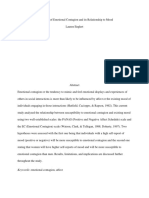Twelve Angry Men
Twelve Angry Men
Uploaded by
Athul GeorgeCopyright:
Available Formats
Twelve Angry Men
Twelve Angry Men
Uploaded by
Athul GeorgeOriginal Description:
Copyright
Available Formats
Share this document
Did you find this document useful?
Is this content inappropriate?
Copyright:
Available Formats
Twelve Angry Men
Twelve Angry Men
Uploaded by
Athul GeorgeCopyright:
Available Formats
Twelve Angry Men Interpersonal communication deals with the techniques of communication used by individuals in their efforts to inform
and persuade among each other and various interpersonal factors including listening, verbal and nonverbal communication, and perception etc influence this process. In other words, an effective interpersonal communication incorporates a number of interpersonal elements, which ultimately convey the dispatchers message successfully to the recipient/s. There are three essential processes which lie beneath every effective communication, such as intrapersonal, interpersonal and public communication, and this paper makes a reflective exploration of the movie Twelve Angry Men in order to point out the complexity of the human communication process. In a profound analysis of this tense, enthusiastic, insightful, and dramatic movie, the three basic processes of communication become evident to the audience and it indicates the vital influence of intrapersonal communication in decision-making. Thus, this paper maintains that the verdict in the jury room is the outcome of the intrapersonal aspects of the jurors and the interpersonal elements of their communication. One of the most important uses of the film Twelve Angry Men in relation to communication theory is that it offers an essential example of the influence of intrapersonal aspects on the human communication process. The intrapersonal process of communication is concerned with how an individual feels about and perceives himself, based on which he creates his perceptions of the outer world. To explain intrapersonal communication, it can be realized as communication within ourselves. Intrapersonal communication is the basis of all other forms of human communication. Without an effective system of intrapersonal communication, an organism is unable to function in its environment. Ideally this communication system allows one to make decisions based on information received through the senses. (Aggarwal and Gupta, 8) A scrupulous analysis of the film Twelve Angry Men confirms that it incorporates
several examples of intrapersonal communication and the various characters of the film are influenced by the values, beliefs and experiences connected with their lives. Thus, the preconceptions and prejudices of each of the twelve jurors indicate their intrapersonal processes of communication, which ultimately result in their verdict of the crime. In other words, a close examination of each of the twelve jurors suggests that these characters are the end-products of their particular intrapersonal aspects based on their life-experiences. Therefore, there are several important instances of intrapersonal communication all through the movie which include positive as well as negative examples.
You might also like
- BIR - Ruling - DA - C-148 - 406-09 - Collection On Behalf of NRFC Not Subject To WHTDocument6 pagesBIR - Ruling - DA - C-148 - 406-09 - Collection On Behalf of NRFC Not Subject To WHTjohn allen MarillaNo ratings yet
- St. Theodore StudiumDocument13 pagesSt. Theodore StudiumB BataviNo ratings yet
- Group 14 - 12 Angry MenDocument11 pagesGroup 14 - 12 Angry MenVamsi_Yanamandra_326No ratings yet
- 12 Angry MenDocument6 pages12 Angry Mensarthak mohan shuklaNo ratings yet
- Definition of ImpressionDocument5 pagesDefinition of ImpressionArslan MalghaniNo ratings yet
- Impression Management NewDocument5 pagesImpression Management Newtejcd1234No ratings yet
- IM B.S ProjectDocument12 pagesIM B.S ProjectPiyush ChoudharyNo ratings yet
- Imagined Personal ExperienceDocument22 pagesImagined Personal ExperienceLanny M HackneyNo ratings yet
- Voices of AttractionDocument6 pagesVoices of AttractionLarry LyonNo ratings yet
- Audience Effects: What Can They Tell Us About Social Neuroscience, Theory of Mind and Autism?Document19 pagesAudience Effects: What Can They Tell Us About Social Neuroscience, Theory of Mind and Autism?Makanudo.No ratings yet
- Analytical Study: Decoding Nonverbal Communication in Law EnforcementDocument16 pagesAnalytical Study: Decoding Nonverbal Communication in Law EnforcementLohitaksh KapoorNo ratings yet
- Digital Emotion ContagionDocument37 pagesDigital Emotion ContagionCarolina BernalNo ratings yet
- Research Paper 2Document13 pagesResearch Paper 2api-455335148No ratings yet
- Psychoanalytic Cyberpsychology: Contemporary Media ForumDocument6 pagesPsychoanalytic Cyberpsychology: Contemporary Media ForumAzwinNo ratings yet
- Translate Psikodrama1Document13 pagesTranslate Psikodrama1Dwien AnugraheniNo ratings yet
- Rehm AndreDocument8 pagesRehm AndreJiewey Wears PradaNo ratings yet
- A Functional Analysis of Imagined InteractionDocument13 pagesA Functional Analysis of Imagined InteractionRydel RatliffNo ratings yet
- Ob Unit-3Document11 pagesOb Unit-3HiiNo ratings yet
- Iri Adolescentes EspañolesDocument14 pagesIri Adolescentes EspañolesjeavilaNo ratings yet
- Ciadmin, Journal Manager, 2737-10949-1-CEDocument10 pagesCiadmin, Journal Manager, 2737-10949-1-CECarl RoosNo ratings yet
- Efektivitas Terapi Film Dalam Meningkatkan Empati Terhadap Mahasiswa Psikologi UIN Raden Fatah PalembangDocument8 pagesEfektivitas Terapi Film Dalam Meningkatkan Empati Terhadap Mahasiswa Psikologi UIN Raden Fatah PalembangAnggik PratamaNo ratings yet
- Unit 2Document111 pagesUnit 2Saratha ShanmugamNo ratings yet
- A Psychosocial Analysis of How First Impressions Are Overcome As Seen in Austen's Pride and Prejudice and Contemporary SituationsDocument25 pagesA Psychosocial Analysis of How First Impressions Are Overcome As Seen in Austen's Pride and Prejudice and Contemporary SituationsGrace OngNo ratings yet
- IntroductionDocument5 pagesIntroductionpgp39363No ratings yet
- Ten Lessons About Negotiation.Document7 pagesTen Lessons About Negotiation.siddard1007No ratings yet
- Characteristics of A Descriptive EssayDocument7 pagesCharacteristics of A Descriptive Essayheffydnbf100% (2)
- Non Verbal Communication SummaryDocument1 pageNon Verbal Communication SummaryAishwaryaNo ratings yet
- Humanising Managerialism Reclaiming Emotional Reasoning Intuition The Relationship and Knowledge and Skills in Social WorkDocument26 pagesHumanising Managerialism Reclaiming Emotional Reasoning Intuition The Relationship and Knowledge and Skills in Social Workphuong nguyenNo ratings yet
- Lesson 03 PDFDocument4 pagesLesson 03 PDFAsgher khkattakNo ratings yet
- TwelveAngryMen Conformity, Attitude Change, Persuasion, Group ProcessesDocument10 pagesTwelveAngryMen Conformity, Attitude Change, Persuasion, Group Processesportucasbas100% (2)
- The Impact of Emotional Contagion and Its Relationship To Mood PDFDocument19 pagesThe Impact of Emotional Contagion and Its Relationship To Mood PDFDi CaNo ratings yet
- The Impact of Emotional Contagion and Its Relationship To Mood PDFDocument19 pagesThe Impact of Emotional Contagion and Its Relationship To Mood PDFDi CaNo ratings yet
- AJ R Chun PHD Asso Pro Write Editor CTSDocument28 pagesAJ R Chun PHD Asso Pro Write Editor CTSAJR Chun PhD CTS FPENo ratings yet
- Violence in MediaDocument83 pagesViolence in MediaArt Is HearTNo ratings yet
- Uncertainty Reduction TheoryDocument3 pagesUncertainty Reduction Theoryapi-283693263No ratings yet
- Twelve Angry Men Movie AnalysisDocument8 pagesTwelve Angry Men Movie Analysisapi-302545255No ratings yet
- EI and Service EncountrsDocument4 pagesEI and Service EncountrsMalék GuerridaNo ratings yet
- Are We The Spaceman (FINAL)Document12 pagesAre We The Spaceman (FINAL)Aline De CosterNo ratings yet
- Interaction Between Human and Robot - An Affect-Inspired ApproachDocument28 pagesInteraction Between Human and Robot - An Affect-Inspired ApproachEseoghene EfekodoNo ratings yet
- Essay On Favourite MovieDocument5 pagesEssay On Favourite Movieafhbebhff100% (2)
- Theories Final PaperDocument10 pagesTheories Final Paperapi-656831384No ratings yet
- ReflectionDocument2 pagesReflectionapi-523366150No ratings yet
- Human Communication Process Session 3Document20 pagesHuman Communication Process Session 3belhsensana99No ratings yet
- According To DuldtDocument6 pagesAccording To Duldtbenzi5No ratings yet
- Application Paper 2Document5 pagesApplication Paper 2api-283623133No ratings yet
- Claudia Bahasa InggrisDocument4 pagesClaudia Bahasa InggrisMohammad Raihan RusbiniNo ratings yet
- PSY1154 Sep 2023 Assignment (Group 20)Document11 pagesPSY1154 Sep 2023 Assignment (Group 20)cheeyin666No ratings yet
- Komunikasi Interpersonal Dan IntrapersonalDocument20 pagesKomunikasi Interpersonal Dan IntrapersonalHansenPanjaitanNo ratings yet
- Handout Interpersonal: # 1 Communication: A Brief IntroductionDocument2 pagesHandout Interpersonal: # 1 Communication: A Brief IntroductionhellomailNo ratings yet
- Psychodrama - Wikipedia The Free EncyclopediaDocument5 pagesPsychodrama - Wikipedia The Free EncyclopedialuciantimofteNo ratings yet
- Psychology of Communication - Between Myth and Reality: Manoela POPESCUDocument5 pagesPsychology of Communication - Between Myth and Reality: Manoela POPESCUirfhyNo ratings yet
- Social Dynamics - Signals and BehaviorDocument5 pagesSocial Dynamics - Signals and BehaviorLarry LyonNo ratings yet
- Beyond Self-Serving Bias: Diffusion of Responsibility Reduces Sense of Agency and Outcome MonitoringDocument8 pagesBeyond Self-Serving Bias: Diffusion of Responsibility Reduces Sense of Agency and Outcome MonitoringJoeNo ratings yet
- Mass Media Assignment 1Document5 pagesMass Media Assignment 1hendrixNo ratings yet
- Ebajan JDocument4 pagesEbajan Japi-710964236No ratings yet
- Impression ManagementDocument5 pagesImpression ManagementanikeitNo ratings yet
- Interpersonal CommuniDocument27 pagesInterpersonal CommuniIndia CorruptionNo ratings yet
- Mindfulness and Interpersonal CommunicationDocument23 pagesMindfulness and Interpersonal CommunicationMuhammad NafiNo ratings yet
- JournalDocument10 pagesJournaltheemee05No ratings yet
- PRAGMATICS Analysis of Humor On Cartoon Comics BE LIKE BRODocument10 pagesPRAGMATICS Analysis of Humor On Cartoon Comics BE LIKE BROabudira2009No ratings yet
- 12 AngrymenDocument6 pages12 Angrymenpgp39363No ratings yet
- Emotional Literacy in Criminal Justice: Professional Practice with OffendersFrom EverandEmotional Literacy in Criminal Justice: Professional Practice with OffendersNo ratings yet
- The Starting: Champaklal Damani Aden Yemen Masjid BunderDocument13 pagesThe Starting: Champaklal Damani Aden Yemen Masjid BunderAthul GeorgeNo ratings yet
- Charismatic LeadershipDocument2 pagesCharismatic LeadershipAthul GeorgeNo ratings yet
- Gun ControlDocument2 pagesGun ControlAthul George100% (1)
- Teachers, Schools, and SocietyDocument2 pagesTeachers, Schools, and SocietyAthul GeorgeNo ratings yet
- The Tale of GenjiDocument2 pagesThe Tale of GenjiAthul GeorgeNo ratings yet
- Gay Marriage IntroDocument1 pageGay Marriage IntroAthul GeorgeNo ratings yet
- GM - Information SystemsDocument18 pagesGM - Information SystemsAthul George100% (1)
- ZARADocument11 pagesZARAAthul George100% (3)
- Song Analysis - Home by Michael BubleDocument1 pageSong Analysis - Home by Michael BubleAthul GeorgeNo ratings yet
- Global Meltdown-Who Is To Be Blamed???Document2 pagesGlobal Meltdown-Who Is To Be Blamed???Athul GeorgeNo ratings yet
- Criminology (Green Criminology)Document5 pagesCriminology (Green Criminology)Athul GeorgeNo ratings yet
- Engineering Science N4 July 2017Document11 pagesEngineering Science N4 July 2017lilspectrex24No ratings yet
- Project Study/Thesis Duties and Responsibilities of AdviserDocument6 pagesProject Study/Thesis Duties and Responsibilities of AdviserLucasNo ratings yet
- Crime Scene InvestigationDocument3 pagesCrime Scene InvestigationAngelito SueroNo ratings yet
- MATH Activity 7Document3 pagesMATH Activity 7EurydiceNo ratings yet
- Never Again Will I Visit Auschwitz - Tablet MagazineDocument16 pagesNever Again Will I Visit Auschwitz - Tablet MagazineNatia MechitishviliNo ratings yet
- Solution Manual For Microeconomics and Behavior 9th Edition Frank 0078021693 9780078021695Document36 pagesSolution Manual For Microeconomics and Behavior 9th Edition Frank 0078021693 9780078021695brianrobertsonogknfzetxw100% (34)
- M365 Modern Desktop Administrator Learning Path (Oct 2019)Document1 pageM365 Modern Desktop Administrator Learning Path (Oct 2019)m00anj00No ratings yet
- Asesor DPK-2013Document35 pagesAsesor DPK-2013AbahRaisyaArinalHaqNo ratings yet
- Gujarat Technological University: Infrastructure For Smart CitiesDocument3 pagesGujarat Technological University: Infrastructure For Smart CitiesJimit PatelNo ratings yet
- L K 1 9 0 0 S S 0 0 0: Good Value Models With JUKI Quality and Friendly To OperatorsDocument4 pagesL K 1 9 0 0 S S 0 0 0: Good Value Models With JUKI Quality and Friendly To Operatorsdharmik borisagarNo ratings yet
- CIVI 6051-Winter 2022-OutlineDocument3 pagesCIVI 6051-Winter 2022-OutlineMartialNo ratings yet
- Module 8 - Introducing Containers and Container ServicesDocument82 pagesModule 8 - Introducing Containers and Container Servicesdoaahemaid01No ratings yet
- Business SimulationDocument3 pagesBusiness SimulationBianca Eunice MarcaidaNo ratings yet
- Guide For Pecb Certified TrainersDocument4 pagesGuide For Pecb Certified TrainersNicholasFCheongNo ratings yet
- Business Management Workbook - Paul Hoang - Fifth Edition - IBID 2022 (1)Document5 pagesBusiness Management Workbook - Paul Hoang - Fifth Edition - IBID 2022 (1)valeriacarranza765No ratings yet
- Clavibacter Michiganensis Subsp. Michiganensis: IdentityDocument5 pagesClavibacter Michiganensis Subsp. Michiganensis: IdentitySadao MatsumotoNo ratings yet
- Determinants of Potato ProductivityDocument45 pagesDeterminants of Potato Productivitywondimu lelegoNo ratings yet
- Lesson PlanDocument7 pagesLesson PlanRONNIE JR. DELA CRUZ BUSALPANo ratings yet
- Blueprints For High Availability - Evan Marcus & Hal SternDocument618 pagesBlueprints For High Availability - Evan Marcus & Hal Sternvangappan2100% (1)
- Mayo Hospital Internship 2024Document2 pagesMayo Hospital Internship 2024anaskhrshdNo ratings yet
- SWIFT MT103 202 Cover Payment Analysis - Part 3 - PaiementorDocument12 pagesSWIFT MT103 202 Cover Payment Analysis - Part 3 - Paiementorswift adminNo ratings yet
- Abt DesDocument83 pagesAbt Dessabir aliNo ratings yet
- Ahmedabad Central JailDocument17 pagesAhmedabad Central JailZankRut VyasNo ratings yet
- DLL 5TH Week EntrepreneurshipDocument4 pagesDLL 5TH Week EntrepreneurshipJose A. Leuterio Jr.100% (1)
- Avanti Fellows - 29 - 03 - 2021 - 11 - 51 - 05Document3 pagesAvanti Fellows - 29 - 03 - 2021 - 11 - 51 - 05chiru charanNo ratings yet
- Time Table For Summer 2024 Theory Examination 6iDocument1 pageTime Table For Summer 2024 Theory Examination 6iXyz AvmcNo ratings yet
- Jizi and His Art in Contemporary China - Unification - David Adam Brubaker, Chuchen WangDocument162 pagesJizi and His Art in Contemporary China - Unification - David Adam Brubaker, Chuchen WangMadhuri RaoNo ratings yet
- Service Manual: Triplex Slush PumpsDocument26 pagesService Manual: Triplex Slush PumpsActivos FijosNo ratings yet




































































































